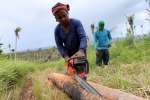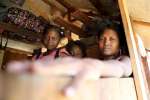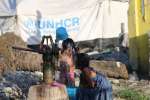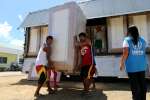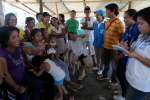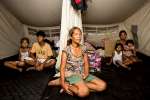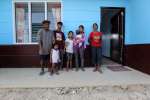- Text size
 |
|  |
|  |
| 
- عربي
Typhoon Haiyan Anniversary: Three generations under one roof in tent city
News Stories, 7 November 2014
TANAUAN, the Philippines, November 7 (UNHCR) – Merlyn Aguilar may live with 12 family members in a tent among hundreds of others in UNHCR's tent city in the central Philippines town of Tanauan, but she has every reason to feel proud.
Since the devastating Typhoon Haiyan smashed into the central Philippines a year ago tomorrow, her family has pulled together with the help of the UN refugee agency and its corporate partner, United Parcel Services (UPS).
When the biggest typhoon ever to hit the Philippines made landfall early on November 8, Merlyn and the children were sheltering at the local gym. Even before arriving at the shelter, the strong winds and heavy rain forced them to abandon the bags of clothing they had packed for evacuation.
"I didn't sleep for three days because I was trying to sleep sitting up. There was nowhere to lie down," says 36-year-old Merlyn. "I gathered 10 chairs, and placed plywood on top so that at least eight of my children had somewhere to sleep."
Her husband Joel managed to rescue her mother, Lola, just in time, but suffered his own losses. His brother, grandfather and aunt are still missing and presumed dead. Thousands of people are thought to have been killed by the typhoon on islands like Leyte, where Tanauan is located.
The new house the Aguilars had been building was destroyed. "The house had some foundation posts built, half of the walls were already cemented – only the roof was lacking," says Merlyn. "We're sad it was all lost. It's really difficult."
Thanks to the emergency funding provided by UPS, the UN refugee agency was able to support them during this difficult time and provide them with a tent, kitchen set, jerry cans, a solar-powered lantern and plastic sheeting. "UNHCR helped us in many ways," says Merlyn. "The greatest help was the tent. Without the tent, we wouldn't have had anywhere else to go."
Her daughter Margelyn, aged 15, adds, "We use the solar lantern when we study, when we cook, and when we go to sleep because we have very young siblings who are afraid of the dark."
It's not just the children who are traumatized. Before the typhoon, Joel went out fishing to supplement the family income, but since Typhoon Haiyan he has not returned to his old trade because of his fear of the sea.
His eldest son, 19-year-old Jomar, looks at the sea with mixed emotions. It is his livelihood but also brings back terrifying memories. At the height of the storm, he was in the shop where he sells fish. He escaped through a window as the wind grew stronger. He recalls hesitantly how he and his siblings fell sick with flu and diarrhoea in the following days, and how scarce food was.
"The worst thing about the typhoon is that I lost my uncle," he says. "Livelihoods were lost, lots of people suffered from hunger, many lost their fishing boats. The sea caused so much destruction."
With an extended family to sustain, everyone has to chip in to help. Margelyn put her education on hold: "After the typhoon, I did not go back to school immediately because I was the one lining up for relief goods. Every time there was a distribution, I volunteered to be the one to line up. I wanted to help, so I told my mother that I won't go back to school."
But she is determined to finish school and become a policewoman to fulfill her grandfather's dream. Her older brothers are working to support the family. Although still very much affected by the typhoon, Jomar feels hopeful about the future: "I want to finish school so I can help my family, improve our lives, and help other people."
For now, the Aguilar family is looking forward to being relocated to a permanent house, somewhere they can all continue to live together more comfortably. At 75, grandma Lola has other ideas. With a shy smile and a twinkle in her eye, she says, "I have been married twice and widowed twice. I would like to marry again and live in my own house."
By Marjanna Bergman in Tanauan, the Philippines





